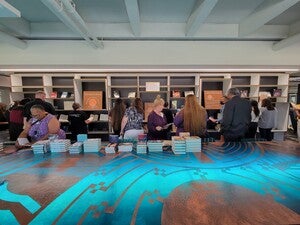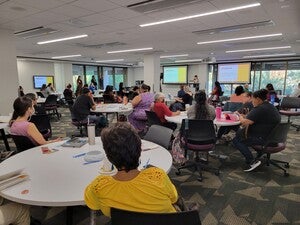
Celebrating Indigenous People’s Day, the Labriola National American Data Center kicked off fall break with the Office of Indian Education’s Changing the Narrative: K-12 Indigenous Literacy and Literature Symposium at Hayden Library. The purpose for this symposium was to educate K-12 teachers on appropriate literary texts about Indigenous peoples that are accurate in representation for classrooms with Native American children and teens. The symposium was in partnership with the Arizona Department of Education and Arizona Humanities. Arizona representatives who attended included Arizona Superintendent Kathy Hoffman, Associate Superintendent Dr. Melissa Castillo, and Deputy Associate Superintendent Lynnann Yazzie. In addition, many Indigenous and non-Indigenous educators from tribal and urban schools participated in the symposium. The day was filled with presentations and workshops highlighting the importance of culturally informed approaches to education, leveraging oral traditions to support academic success, and best practices for teaching Indigenous texts in the classroom.

The Labriola Center contributed to the symposium by leading an interactive workshop that utilized a book display, specially created for the symposium, called “Information is Sacred.” The expression “Information is Sacred” comes from the Labriola Center’s mission, vision, and values statement meaning that Indigenous knowledge, whether it be art, music, oral storytelling, literary text, or academic research, is important to our communities and our cultural values, which should be treated with respect. This “Information is Sacred” book display circumscribes our mission in academic research, stewardship of stories, and cultural protocols with traditional knowledge. The Labriola Center’s librarians, Director Alex Soto and archivist Vina Begay, created a Libguide and presentation for teachers that display books in Labriola’s open collection that are questionable and not questionable for teaching Indigenous children in the classroom. Generally, books that are authored and written by community members of that tribe are normally not misrepresentative or dehumanizing. However, it is integral to investigate the author and title of the material, especially because there is knowledge within Indigenous communities that are culturally sensitive and not meant to be shared outside the tribe or shared during certain seasons. This book display will extend beyond the Symposium at our open stacks collection on the second floor of Hayden library. Students, staff, faculty, and the greater community can come and interact with the display at any time.

Within the book display are signs asking questions that prompt the reader to further investigate books. For representation, the sign asks, “is the author an Indigenous person? How are Natives represented in the title, the cover, and within the pages?” For Cultural Information, the sign asks “if you think the material contains cultural information? and “Does the material contradict traditional knowledge?” For Literary Text, the signs asks, “does the terminology depict Indigenous Tribal Nations well? Does the material dehumanize Indigenous Tribal Nations?” As the reader is reviewing the signs, for example, the reader may find a book title that says, “The Ojibway Indians Observed.” The book display signs would prompt you to ask, Who is observing them and does the title seem to objectify this group of people? Additionally, you could also ask, is “Ojibway” accurate? Through the prompts, the reader may find that most tribal names are names that originate from settler colonialism and erase their own cultural or traditional names. With my tribe, Diné (“Of the People”), we have been called “Navajo, Navaho, etc.” by early Spanish settlers. This term is an adaptation of “Apaches de Nabajó,” which translates to “Enemies who farm in the valley.” So when approaching books that speak on tribes, be aware of the terminologies used and who is narrating the story, and ask the questions that the book signs are asking to help your analysis of the books.

Some of the books featured in the display are “Ensouling Our Schools,” by Jennifer Katz and Kevin Lamoureux (Call number: LC1203.C2 K38 2018), “To Show What an Indian Can Do” by John Bloom (Call number: E98.G2 B56 2000), and “Elatsoe” by Darcie Little Badger (Call number: PS3612.I8768 E43 2020). Do any of these titles fall under a questionable category? Come experience our book display until the remainder of the Fall 2022 semester to get a taste of what the attendees at the symposium experience, and learn about why Information is Sacred. Furthermore, learn how Indigenous representation in Labriola’s open stacks and reading materials are important.
By Yitazba Largo-Anderson and Eric Hardy
